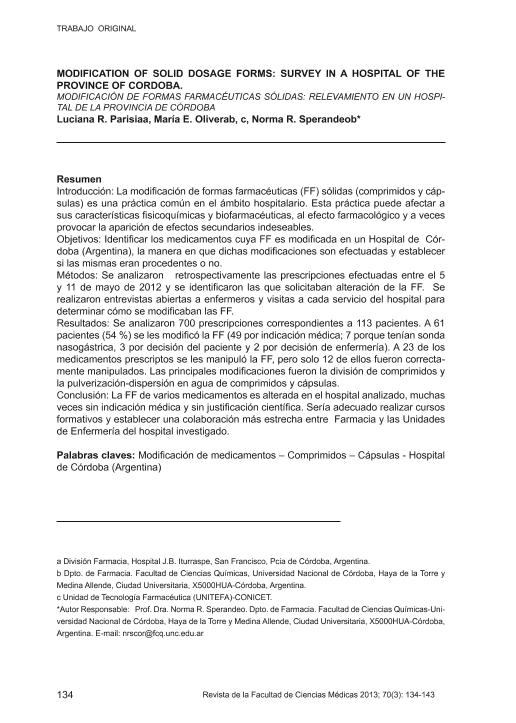Artículo
Introducción: La modificación de formas farmacéuticas (FF) sólidas (comprimidos y cápsulas) es una práctica común en el ámbito hospitalario. Esta práctica puede afectar a sus características fisicoquímicas y biofarmacéuticas, al efecto farmacológico y a veces provocar la aparición de efectos secundarios indeseables. Objetivos: Identificar los medicamentos cuya FF es modificada en un Hospital de Córdoba (Argentina), la manera en que dichas modificaciones son efectuadas y establecer si las mismas eran procedentes o no. Métodos: Se analizaron retrospectivamente las prescripciones efectuadas entre el 5 y 11 de mayo de 2012 y se identificaron las que solicitaban alteración de la FF. Se realizaron entrevistas abiertas a enfermeros y visitas a cada servicio del hospital para determinar cómo se modificaban las FF. Resultados: Se analizaron 700 prescripciones correspondientes a 113 pacientes. A 61 pacientes (54 %) se les modificó la FF (49 por indicación médica; 7 porque tenían sonda nasogástrica, 3 por decisión del paciente y 2 por decisión de enfermería). A 23 de los medicamentos prescriptos se les manipuló la FF, pero solo 12 de ellos fueron correctamente manipulados. Las principales modificaciones fueron la división de comprimidos y la pulverización-dispersión en agua de comprimidos y cápsulas. Conclusión: La FF de varios medicamentos es alterada en el hospital analizado, muchas veces sin indicación médica y sin justificación científica. Sería adecuado realizar cursos formativos y establecer una colaboración más estrecha entre Farmacia y las Unidades de Enfermería del hospital investigado. Background: In the hospital setting is frequent to manipulate solid dosage forms (SDF, tablets 16and capsules), which can affect their physicochemical and biopharmaceutical properties, the pharmacoloeffect and sometimes to cause the appearance of undesirable side effects. Objectives: To identify the medicines whose SDF is altered in a Hospital of Cordoba (Argentina), to determine how these modifications are made and to establish whether they were properly performed or not. Methods: We retrospectively analyzed the prescriptions made between the 5th and the 11th of March of 2012 and identified impaired requesting SDF modifications. Open interviews were held with nurses and service visits to each hospital to determine how they manipulated the SDF. Results: We analyzed 700 prescriptions for 113 patients, of which 61 (54%) had manipulations of the received SDF (49 for medical prescription, 7 because they had nasogastric tubes, 3 due to patient choice and 2 by nursing decision). Twenty three medicines were manipulated, but only 12 were correctly manipulated. The major changes were partition of tablets and grinding of tablets or microgranules and dispersible in water. Conclusion: The SDF of several medicines is altered in the analyzed hospital, many times without medical indication and scientific justification. It would be appropriate to conduct training courses and establish closer collaborations between pharmacy and nursing units in the investigated hospital.
Modification of solid dosage forms: survey in a hospital of the province of Cordoba
Título:
Modificación de formas farmacéuticas sólidas: relevamiento en un hospital de la provincia de Córdoba
Fecha de publicación:
12/2013
Editorial:
Universidad Nacional de Córdoba. Facultad de Ciencias Médicas
Revista:
Revista de la Facultad de Ciencias Médicas de Córdoba
ISSN:
0014-6722
Idioma:
Español
Tipo de recurso:
Artículo publicado
Clasificación temática:
Resumen
Palabras clave:
Modificacion de Medicamentos
,
Comprimidos
,
Capsulas
,
Hospital de Cordoba
Archivos asociados
Licencia
Identificadores
Colecciones
Articulos(UNITEFA)
Articulos de UNIDAD DE INVESTIGACION Y DESARROLLO EN TECNOLOGIA FARMACEUTICA
Articulos de UNIDAD DE INVESTIGACION Y DESARROLLO EN TECNOLOGIA FARMACEUTICA
Citación
Parisia, Luciana R.; Olivera, Maria Eugenia; Sperandeo, Norma Rebeca; Modification of solid dosage forms: survey in a hospital of the province of Cordoba; Universidad Nacional de Córdoba. Facultad de Ciencias Médicas; Revista de la Facultad de Ciencias Médicas de Córdoba; 70; 3; 12-2013; 134-143
Compartir




